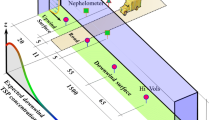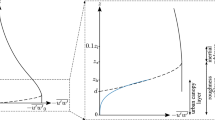Abstract
Low wind speed conditions are often associated with poor air quality in urban areas, especially near roadways. Predictions of pollutant concentration under such conditions, i.e. low wind-speeds and near road locations, are, however, complicated by the role of traffic produced turbulence (TPT) on pollutant mixing and dilution. Existing dispersion models consider the effect of TPT on pollutant concentrations near roadways, accounting for parameters such as vehicle intensity, vehicle speeds, etc, but do not explicitly account for the contribution of two-way traffic interaction on the pollutant dispersion parameter. The turbulent kinetic energy (TKE) resulting from a two-way traffic condition will be higher than that with a one-way traffic pattern. Here, we obtain a simple formulation for TKE under a two-way traffic pattern from the balance of production and dissipation of turbulence. Considering the vorticity generated by the two-way traffic and determining the equivalent drag coefficient, an expression for TKE due to the two-way traffic interaction was obtained for three different traffic density regimes: light, intermediate, and heavy. The model predictions are validated by comparison with published data from a field study. An improved parameterization of the TPT considering the two-way traffic interaction effect is seen to significantly improve predictions of near roadway pollutant concentrations.
Similar content being viewed by others
Abbreviations
- CALINE4:
-
CAlifornia LINE source dispersion model version 4
- CFD:
-
Computational fluid dynamics
- CPBM:
-
Canyon plume box model
- GM:
-
General Motors
- HDV:
-
Heavy duty vehicle
- LDV:
-
Light duty vehicle
- OSPM:
-
Operational street pollution model
- QUIC:
-
Quick urban and industrial complex dispersion model
- TKE:
-
Turbulent kinetic energy
- TPT:
-
Traffic produced turbulence
References
Fenger J (1999) Urban air quality. Atmos Environ 33: 4877–4900
Gidhagen L, Johansson C, Langner J, Foltescu V (2005) Urban scale modeling of particle number concentration in Stockholm. Atmos Environ 39: 1711–1725
Peters A, Dockery DW, Muller JE, Mittleman MA (2001) Increased particulate air pollution and the triggering of myocardial infarction. Circulation 103: 2810–2815
Samet JM (2007) Traffic, air pollution, and health. Inhalation Toxicol 19(12): 1021–1027
Noll KE, Miller TL, Claggett M (1978) A comparison of three highway line source models. Atmos Environ 12: 1323–1329
Benson PE (1984) CALINE4—a dispersion model for predicting air pollutant concentrations near roadways. FHWA-CA-TL-84-15, California Department of Transportation, Sacramento, CA
Berkowicz R (2000) A parameterized street pollution model. Environ Monit Assess 65: 323–331
Stull RB (1988) An introduction to boundary layer meteorology. Kluwer Academic Publishers, Dordrecht, p 666
Berkowicz R, Ketzel M, Vachon G, Louka P, Rosant J-M, Mestayer P, Sini J-F (2002) Examination of traffic pollution distribution in a street canyon using the Nantes’99 experimental data and comparison with model result. Water Air Soil Pollut Focus 2: 311–324
Di Sabatino S, Kastner-Klein P, Berkowicz R, Britter R, Fedorovich E (2003) The modeling of turbulence from traffic in urban dispersion models—Part I: theoretical considerations. Environ Fluid Mech 3: 129–143
Kastner-Klein P, Fedorovich E, Ketzel M, Berkowicz R, Britter R (2003) The modeling of turbulence from traffic in urban dispersion models—Part II: evaluation against laboratory and full-scale concentration measurements in street canyons. Environ Fluid Mech 3: 145–172
Britter RE, Hanna SR (2003) Flow and dispersion in urban areas. Annu Rev Fluid Mech 35: 469–496
Mazzeo NA, Venegas LE (2005) Evaluation of turbulence from traffic using experimental data obtained in a street canyon. Int J Environ Pollut 25: 164–176
Solazzo E, Vardoulakis S, Cai X (2007) Evaluation of traffic-producing turbulence schemes within operational street pollution models using roadside measurements. Atmos Environ 41: 5357–5370
Vachon P, Louka G, Rosant J-M, Mestayer P, Sini J-F (2002) Measurements of traffic-induced turbulence within a street canyon during the Nantes’99 experiment. Water Air Soil Pollut Focus 2: 127–140
Rao ST, Sedefian L, Czapski UH (1979) Characteristics of turbulence and dispersion of pollutants near major highways. J Appl Meteorol 18: 283–293
Cadle SH, Chock DP, Monson PR, Heuss JM (1977) General Motors sulfate dispersion experiment: experimental procedures and results. J Air Pollut Control Assoc 27: 33–38
Chock DP (1980) General Motors sulfate dispersion experiment: an analysis of the wind field near a road. Bound Layer Meteorol 18: 431–451
Sedefian L, Rao ST, Czapski U (1981) Effects of traffic-generated turbulence on near-field dispersion. Atmos Environ 15: 527–536
Corsmeier U, Kohler M, Vogel B, Vogel H, Fiedler F (2005) BAB II: a project to evaluate the accuracy of real world traffic emissions for a motorway. Atmos Environ 39: 5627–5641
Kalthoff N, Bäumer D, Corsmeier U, Kohler M, Vogel B (2005) Vehicle-induced turbulence near a motorway. Atmos Environ 39: 5737–5749
Vardoulakis S, Fisher BEA, Pericleous K, Gonzalez-Flesca N (2003) Modeling air quality in street canyons: a review. Atmos Environ 37: 155–182
Yamartino RJ, Wiengand G (1986) Development and evaluation of simple model for the flow, turbulence and pollutant concentration fields within an urban street canyon. Atmos Environ 20: 2137–2156
Hertel O, Berkowicz R (1989) Operational street pollution model (OSPM). Evaluation of model on data from St. Olavs street in Oslo. DMU Luft A-135
Bäumer D, Vogel B, Fiedler F (2005) A new parameterisation of motorway-induced turbulence and its application in a numerical model. Atmos Environ 39: 5750–5759
Kastner-Klein P, Clark JV (2004) Modeling of flow and dispersion characteristics in typical urban building configurations with the fast-response model QUIC. Proc of the 5th AMS conference on the urban environment, Vancouver, BC, Canada, 23–26 Aug
Kastner-Klein P, Fedorovich E, Rotach M (2001) A wind tunnel study of organised and turbulent air motions in urban street canyons. J Wind Eng Ind Aerodyn 89: 849–861
Kastner-Klein P, Berkowicz R, Plate EJ (2000) Modeling of vehicle-induced turbulence in air pollution studies for streets. Int J Enviorn Pollut 14: 496–507
Kondo H, Tomizuka T (2009) A numerical experiment of roadside diffusion under traffic-produced flow and turbulence. Atmos Environ 43: 4137–4147
Hinze JO (1975) Turbulence. McGraw Hill, New York
Saffman PG (1992) Vortex dynamics. Cambridge university press, New York
Eskridge RE, Hunt JCR (1979) Highway modeling. Part I: prediction of velocity and turbulence fields in the wake of vehicles. J Appl Meteorol 18: 387–400
Author information
Authors and Affiliations
Corresponding author
Rights and permissions
About this article
Cite this article
He, M., Dhaniyala, S. A dispersion model for traffic produced turbulence in a two-way traffic scenario. Environ Fluid Mech 11, 627–640 (2011). https://doi.org/10.1007/s10652-011-9215-2
Received:
Accepted:
Published:
Issue Date:
DOI: https://doi.org/10.1007/s10652-011-9215-2




